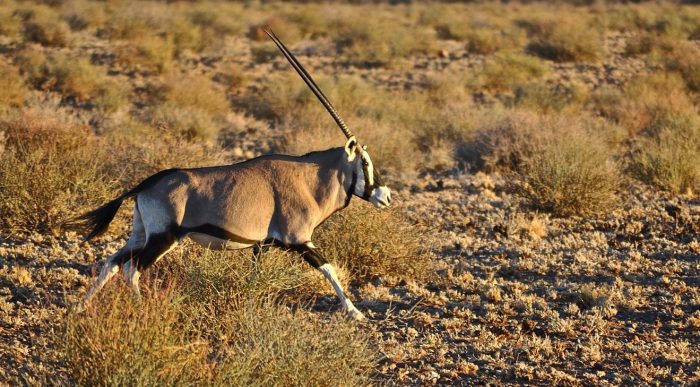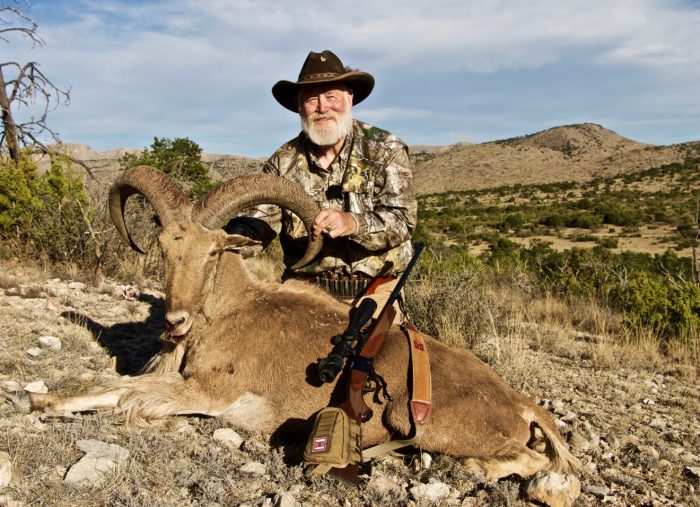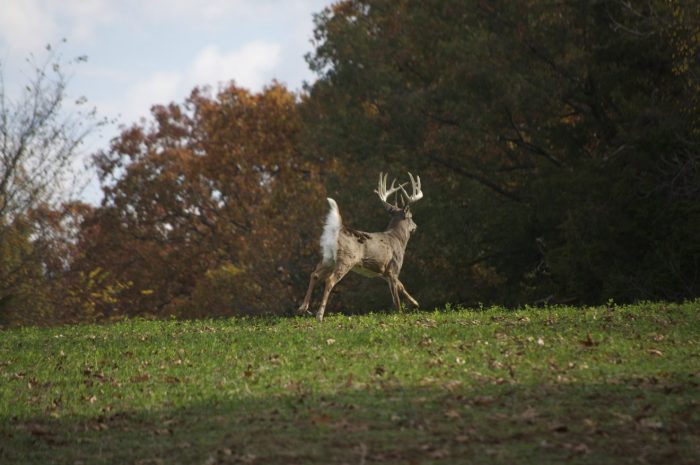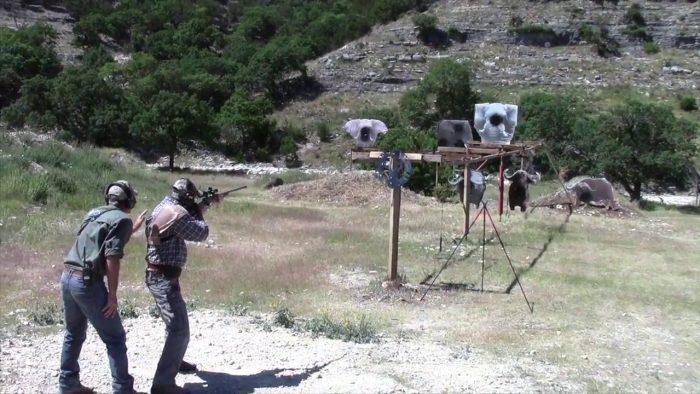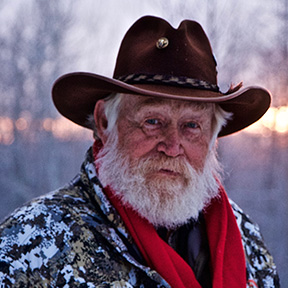Shooting Running Game, “Prose” and Cons
The cottontail broke from the briar thicket running, ducking and dodging. I shouldered my Remington .22 rimfire, placed the front bead just in front of the quartering-away rabbit’s nose, then pulled the trigger, following through as I would with a shotgun. The rabbit died in mid-stride. Moments later, my four beagles arrived on the scene. I reached down, picked up my prize, admired it briefly, said a prayer of thanks, then shoved supper into my hunting vest.
Thirty minutes later, my beagles brought another cottontail past me. This one, too, I shot with my .22 rimfire as it ran past, placing a single bullet in my quarry’s vitals. I reached my goal: two fat, tasty rabbits bagged to provide succulent meat for my bride, two guests, and me. I headed home.
Now you’re asking yourself, “What? Shooting running game with a rifle? Really???”
There was a time when that is what I did. I prided myself on my ability to shoot running game, be it rabbits, deer, or even antelope. Back then, I regularly practiced shooting running game by shooting jackrabbits and cottontails with .22s, and, where I could safely do so, with my .257 Roberts and .270 Winchester deer rifles.
In my youth, I often read articles by Jack O’Connor, Elmer Keith, and others about successfully shooting running game. Back then, too, it was not uncommon to hunt deer with dogs and by doing deer drives. On such hunts, if you waited for a deer to stop before shooting, chances are you were not going to be pulling the trigger.
Fast forward to my days as a wildlife disease specialist; quite often, we were after specific animals, and they were seldom standing still. Out of necessity, I continued shooting running animals. And I did so frequently.
Then for a while, I hunted almost exclusively with handguns. At that point, I essentially quit shooting running game. About that time, too, I started doing outdoor television shows which frowned at shooting running game.
Even so, I continued practicing shooting at running animals, but only if a second or third follow-up shot was needed.
Thoughts on Shooting Running Game
These days here in North America, compared to several years ago, initial running shots are frowned upon, and for good reason. Hardly anyone today practices shooting running animals, so they are not proficient in placing a bullet in the vitals of running game.
Interesting how attitudes have changed regarding shooting running game over a generation. Hunter notable, Craig Boddington, in his Safari Press book “SHOTS AT BIG GAME, How to Shoot a Rifle Accurately Under Hunting Conditions” states, “John Wootters once said the best thing we could do for America’s game conservation efforts would be to convince hunters that their rifles would not fire unless their intended quarry was standing perfectly still.”
In reading Boddington’s prose on the subject, he (like others) has taken running shots, but he, too, had practiced for them. He also suggests not taking a running shot for the initial effort, and only shooting at running game after an animal has been hit and is escaping.
One of the people, a friend with whom I have hunted in Africa, Europe, Asia, and here in North America, and someone for whom I have great respect as a hunter, shooter, conservationist, and educator is Tim Fallon. Fallon heads the FTW Ranch’s Sportsman All-Weather, All-Terrain Marksmanship (SAAM) training.
When I asked Tim about whether or not one should take shots at running game, he replied, “You have to take a stand somewhere, and ours here at SAAM is, ‘It is the hunter’s job to kill the animals with one shot!’” He continued, “With that being said, the chances of killing the animal with one shot while running greatly diminishes by a huge factor. Beyond 100 yards, the chances are close to zero unless you’re really good at hitting moving targets with a rifle. Most people are not, not even after training here at the ranch … Will, they hit it? Probably. But kill it with one shot? Probably not!”
Fallon went on to say, “We do teach moving target shooting at 25, 100 and 150 yards. However, we stress, emphasize, and then reemphasize: ‘Never shoot at a moving target on first round shots. Moving targets are only shot at after initially shooting your quarry standing still, as a follow up shot.’”
After visiting with Fallon, I asked Corey Mason, Executive Director of DSC (Dallas Safari Club), a fellow professional wildlife biologist who has considerable hunting experience both here in North America and abroad, about taking running shots. He said, “I agree with Tim Fallon’s practice and philosophy. From a North American perspective [noting the traditions of European driven hunts], I believe that most hunters lack the skills [practice] to proficiently and ethically take running game.”
Corey brought up the European tradition of driven hunts, which presents some interesting questions. These are accepted ways to hunt on the continent. In years past, I have on several occasions been involved in driven hunts in Europe, and even here in North America for whitetail, and in years past for mule deer and wild hogs.
European Driven Hunting
For this reason, I asked Neil Davies with Hornady ammunition some questions. Neil, too, has hunted throughout the world, and a fair amount in Europe, including on a television show called “Wild Boar Fever,” which shows how effective those trained and practiced in making running shots are at shooting running game.
“I personally killed wild boars out to 100-ish meters on driven hunts, but I have had proper training,” he said. “I was sure of my shot and had ample space to be able to take a follow-up shot if necessary. But most of all I was sure of my FIRST shot!”
Neil said that in the United Kingdom, it is acceptable to shoot animals past 200 meters, provided you have proper training. However, hunters are not encouraged to take shots at running game. He said that, on the European continent, shooting beyond 200 meters is considered unethical, but hunters are welcome to shoot running game. In fact, driven hunts are considered the pinnacle of the hunting experience in Europe.
“In my travels I have found that ethics can be geographical, but the desire to swiftly dispatch an animal is universal and incontrovertible,” he said.
By comparison, Neil said that in the United States, it’s okay to shoot running coyotes or wild hogs, regardless of the range, but shooting at running game animals, like deer, isn’t condoned, at least for the first shot.
“Personally, I’m a big proponent of encouraging folks to keep shooting at a mortally wounded animal until you know it’s dead,” he said. “So, shoot them well and shoot them until they are no longer moving. We owe animals that much!”
He said that even fatal first shots don’t necessarily drop an animal on the spot, and a follow-up shot may be required.
“All animals have their own unique will to live,” Neil said. “Even a fatal shot does not always anchor them. When they get up, they are almost always moving, running. For that reason, we should all learn to be reasonably proficient at hitting running game. I remember old time coyote hunters in our area practiced shooting running game by putting a balloon inside an old tire and then shooting as it rolled down a slope.”
Neil shoots a lot and regularly practices hitting moving targets with a rifle. For this reason, he said he has no issue shooting a running deer under the right circumstances – range, speed, and all other variables being agreeable.
“But, if I had to choose, I want the animals I shoot at to be stationary,” he said. “Then I will be ready for quick follow-up shots. I’m also willing to let an animal walk, or run, out of my sight picture, and my life, if I do not have a clear shot or feel good about taking the shot.”
Great advice from those with tremendous hunting experience. When it come to taking running shots, go with what the pros suggest, and if you want stories about those who have made unbelievable running shots, leave it to the “prose”!
Professional wildlife biologist/outdoor communicator, Larry Weishuhn, known to many as “Mr. Whitetail”, has established quality wildlife management programs on over 12,000,000 acres throughout North American and other parts of the world. He has hunted big game with rifle and/or handgun on six continents. Larry is a Professional Member of the Boone & Crockett Club, life-member of numerous wildlife conservation organizations including the Dallas Safari Club, Mule Deer Foundation, and Wild Sheep Foundation. He currently serves on the DSC Foundation Board of Directors, is one of three co-founders of the Texas Wildlife Association; is a member of the Legends of the Outdoors Hall of Fame and the Muy Grande Hall of Fame; he too, received the Zeiss Lifetime Achievement Award among many other honors.

